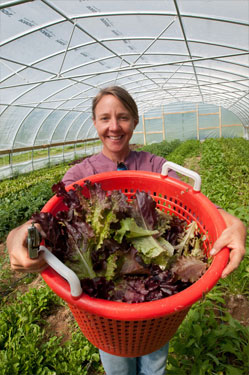|
|
 |
PAGE 17 / 87 |
 |
Unit 1: Planning and Business Development
 |
Amy's Organic Garden owner Amy Hicks harvests greens at her farm in Charles City, Virginia. (Photo by Lance Cheung/USDA, CC BY 2.0) |
Farmers may have strong feelings or fixed ideas about how to solve a problem or best approach a new market opportunity. If they have not done much research at this point or are clearly in the start-up phases, encourage them to brainstorm alternatives with family members, with an advisory team or another farmer who has pursued a similar business strategy.
Brianstorm. When brainstorming new business ideas and strategies don’t be afraid to think outside the box (or as Michigan State University Associate Professor of Tourism and Agriculture Ed Mahoney says, “create a new box”) by considering some of the alternatives that farmers and ranchers might adopt:
-
Add value to existing products: processing and packaging.
-
Incorporate non-traditional ranch and farm animals/crops.
-
Explore new marketing and distribution alternatives.
-
Add farm and ranch recreation and tourism.
-
Adapt and re-use buildings, spaces and equipment.
-
Consider leases, easements, shares and time-shares.
-
Offer contracts and services such as expertise, consulting, education.
Following the brainstorming session, return to the farmer’s vision and goals or the SWOT analysis if one has been prepared. Use these as tools to identify the most appropriate strategic alternatives for the business. If a new idea or strategy seems like a good fit – it reflects the personal, financial, social and ecological values and goals of those involved – it’s time to explore the technical and financial feasibility of that idea. |